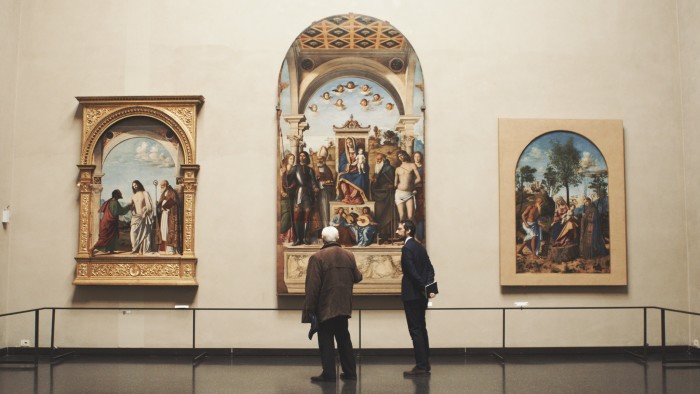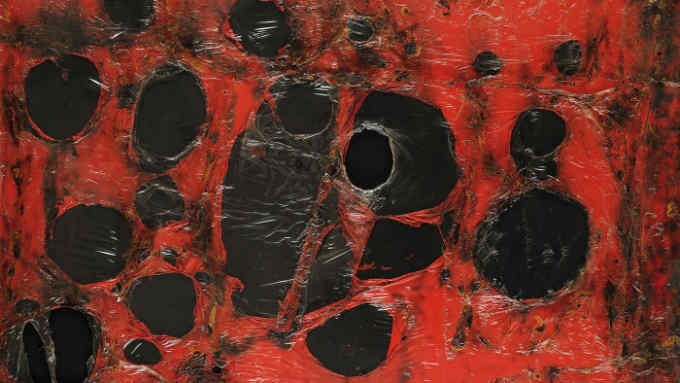A step forward for Venice’s Accademia Gallery — with its first living artist

Simply sign up to the Arts myFT Digest -- delivered directly to your inbox.
For most art lovers, the Accademia Gallery in Venice is indelibly associated with Renaissance masterpieces such as “The Tempest” by Giorgione. This week, however, visitors might be forgiven for thinking they have walked into a contemporary art museum.
The exhibition by Georg Baselitz, the first living artist to be shown in the museum, whose permanent collection concentrates on pre-19th-century art, is garnering the most attention. However the Accademia is currently home to another project that is, arguably, even more progressive.
Entitled Aurale: Brusii per Audioguide (Aural: Rumbles for Audioguides), the exhibition is the fruit of the gallery’s first residency for a contemporary artist. At its core are audio guides designed by the Vercelli-born artist Claudio Beorchia, who was awarded a residency in January this year. Through the earpieces, visitors hear a soundtrack of voices recorded by Beorchia during his three-month sojourn in the museum.
Dressed as a museum attendant, Beorchia was able to surreptitiously register the remarks made by people as they stood in front of the paintings. Gems include one guest who perceived that the San Sebastian who graces Bellini’s San Giobbe Altarpiece is “the hottest”.
Behind the residency lies a story that encapsulates the challenges and hopes of Venice today. For Beorchia’s opportunity came about as a result of a collaboration between the Accademia Gallery, the Accademia di Belli Arti — Venice’s art school — and the non-profit association We Are Here Venice (WahV), which aims to sustain Venice as a living city through both research projects and practical initiatives. Funding for the project, to the tune of €15,000, was provided by the London Stock Exchange Group Foundation. WahV provided the artist’s accommodation and assembled further private donations of €10,000.
That three separate Venetian organisations came together signals an effort to heal historic divisions between the city and its institutions. Founded in 1750, both the gallery and the school were originally part of one complex. But in 1879, the museum was detached from the school. The city meanwhile suffered its own wounds. Unstoppable tourism allied to poor municipal governance and rising house prices has diminished the quality of life for residents, whose numbers sink every year. (They currently stand at 54,000 compared to 175,000 in the postwar era.)
According to WahV co-director Jane da Mosto, the initiative “served to remind people to visit the museum and feel more connected to the rich heritage that is part of being Venetian. It shows that what we think and feel about the paintings counts for something.”
The gallery confirms da Mosto’s theory. According to Michele Tavola, curator of contemporary art at the Accademia Gallery, “the residency has catalysed a more vibrant dialogue with local inhabitants.” In particular, Beorchia’s presence triggered great interest on the part of Venice’s two universities — Iuav and Ca’ Foscari. “They have brought students for numerous encounters with Claudio,” Tavola continued.
Speaking from the Academy of Fine Arts, art history professor Gloria Vallese points out that the residency is part of a long-term programme to re-cement relations with the museum that will include exhibitions and educational initiatives. That desire to unite past and present reflects the evolving concerns of contemporary art students.
“In the 1970s, our students repudiated the art of the past,” Vallese says. “But today the language of art is more complex. We see that our students are studying the paintings at the Accademia with renewed interest.”
Beorchia’s presence as clandestine witness is proving useful to the museum as they develop ways to improve visitors’ experience. “It’s been helpful in drawing attention to the way people actually interact with the works,” says Tavola — an element often overlooked by curators who tend to pay more attention to the art than the response it triggers.
It’s also had its humorous moments. “I discovered that visitors kiss each other under the profane landscapes rather than in the rooms full of religious paintings,” Beorchia recalls. “Romantic couples don’t want saints looking at them!”
Aurale: Brusii per Audioguide, May 12, Accademia Gallery, Venice, gallerieaccademia.it
Follow @FTLifeArts on Twitter to find out about our latest stories first. Subscribe to FT Life on YouTube for the latest FT Weekend videos

Comments